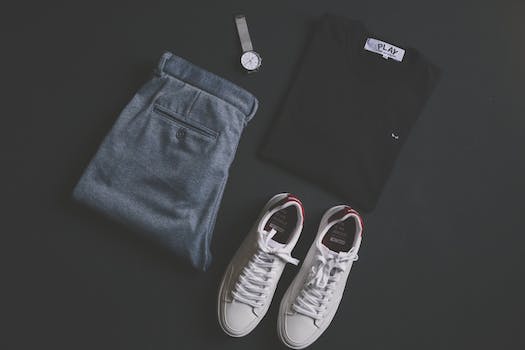

-
Table of Contents
"Revolutionizing Fashion: Pioneering Sustainable Innovations and Trendsetting for a Greener Future."
Introduction
The future of sustainable fashion is a topic of increasing importance as the fashion industry faces growing scrutiny for its environmental and social impact. Innovations and trends in sustainable fashion are emerging to address these concerns and pave the way for a more sustainable future. This article explores the various innovations and trends that are shaping the future of sustainable fashion, from eco-friendly materials and production methods to circular fashion and ethical practices. By embracing these innovations and trends, the fashion industry has the potential to transform itself into a more sustainable and responsible industry.
The Role of Technology in Advancing Sustainable Fashion
The fashion industry has long been criticized for its negative impact on the environment. From the excessive use of natural resources to the pollution caused by textile production, the industry has been a major contributor to global environmental issues. However, in recent years, there has been a growing movement towards sustainable fashion, with designers and brands embracing innovative technologies to reduce their ecological footprint.
Technology has played a crucial role in advancing sustainable fashion. One of the key areas where technology has made a significant impact is in the development of sustainable materials. Traditional textiles, such as cotton and polyester, require large amounts of water and energy to produce. However, advancements in technology have led to the creation of new materials that are more environmentally friendly.
For example, scientists have developed fabrics made from recycled plastic bottles, known as rPET. These fabrics have the same properties as traditional textiles but are produced using a fraction of the energy and water. Similarly, there have been advancements in the production of sustainable leather alternatives. Companies are now using plant-based materials, such as pineapple leaves and mushroom fibers, to create leather-like materials that are biodegradable and cruelty-free.
In addition to sustainable materials, technology has also revolutionized the manufacturing process. 3D printing, for instance, has emerged as a game-changer in the fashion industry. This technology allows designers to create intricate designs without the need for excessive material waste. By printing garments layer by layer, 3D printing reduces the amount of fabric needed, resulting in less waste and a more sustainable production process.
Furthermore, technology has enabled brands to improve supply chain transparency. Blockchain technology, for example, allows consumers to trace the journey of a garment from its origin to the store shelf. This transparency ensures that the garment was produced ethically and sustainably, giving consumers peace of mind and encouraging brands to adopt more sustainable practices.
Another area where technology has made a significant impact is in the recycling and upcycling of fashion waste. With the rise of fast fashion, the amount of textile waste generated has reached alarming levels. However, technology has provided innovative solutions to tackle this issue. Companies are now using advanced recycling technologies to transform textile waste into new fibers that can be used to create new garments. This not only reduces the amount of waste sent to landfills but also conserves valuable resources.
Moreover, technology has also facilitated the rise of rental and sharing platforms, which promote a more sustainable approach to fashion consumption. These platforms allow consumers to rent clothing for a specific period, reducing the need for excessive production and minimizing waste. By sharing garments, consumers can enjoy a variety of styles without contributing to the environmental impact of the fashion industry.
In conclusion, technology has played a crucial role in advancing sustainable fashion. From the development of sustainable materials to the improvement of manufacturing processes and supply chain transparency, technology has enabled the fashion industry to reduce its ecological footprint. As technology continues to evolve, we can expect even more innovative solutions that will shape the future of sustainable fashion. By embracing these advancements, the fashion industry can move towards a more sustainable and environmentally friendly future.
Circular Economy and its Impact on the Fashion Industry

The fashion industry has long been associated with excess and waste. From the production of textiles to the disposal of garments, the industry has had a significant impact on the environment. However, in recent years, there has been a growing movement towards sustainability in fashion. One of the key concepts driving this movement is the circular economy.
The circular economy is an economic system that aims to eliminate waste and keep resources in use for as long as possible. In the context of the fashion industry, this means rethinking the way garments are produced, used, and disposed of. Instead of the traditional linear model of production and consumption, where garments are made, used, and then discarded, the circular economy promotes a closed-loop system.
In a circular economy, garments are designed to be durable, repairable, and recyclable. This means using high-quality materials that can withstand multiple uses and designing garments in a way that allows for easy repairs. Additionally, at the end of a garment's life, it can be recycled into new materials, reducing the need for virgin resources.
The impact of the circular economy on the fashion industry is significant. By shifting towards a closed-loop system, the industry can reduce its reliance on finite resources and minimize waste. This not only benefits the environment but also has economic advantages. According to a report by the Ellen MacArthur Foundation, transitioning to a circular economy in the fashion industry could generate $560 billion in savings by 2030.
Several innovative initiatives and technologies are driving the adoption of the circular economy in fashion. One such initiative is the rise of rental and subscription services. Instead of buying garments outright, consumers can now rent them for a specific period. This not only reduces the demand for new garments but also allows for a more efficient use of existing ones. Additionally, subscription services provide consumers with a constant supply of new garments without the need for constant purchasing.
Another innovation in the circular economy is the development of new materials and production techniques. For example, companies are now experimenting with using recycled materials, such as plastic bottles and old garments, to create new textiles. Additionally, advancements in technology, such as 3D printing, allow for more precise and efficient production, reducing waste in the manufacturing process.
The circular economy also encourages the adoption of sustainable business models. This includes practices such as take-back programs, where companies collect and recycle old garments, and extended producer responsibility, where manufacturers are responsible for the entire lifecycle of their products. These initiatives not only reduce waste but also create opportunities for new revenue streams and customer loyalty.
While the circular economy holds great promise for the fashion industry, there are still challenges to overcome. One of the main challenges is changing consumer behavior. Encouraging consumers to embrace a more sustainable approach to fashion requires education and awareness. Additionally, there is a need for greater collaboration and coordination among stakeholders, including designers, manufacturers, retailers, and consumers.
In conclusion, the circular economy is revolutionizing the fashion industry. By promoting a closed-loop system, the industry can reduce waste, conserve resources, and generate economic benefits. Through innovative initiatives and technologies, such as rental services and recycled materials, the fashion industry is embracing sustainability. However, to fully realize the potential of the circular economy, there is a need for widespread adoption and collaboration. Only by working together can we create a future where fashion is both stylish and sustainable.
Sustainable Materials and Fabrics: Exploring Alternatives for a Greener Future
Sustainable fashion has become a hot topic in recent years as consumers and fashion brands alike are becoming more aware of the environmental impact of the fashion industry. One area that has seen significant innovation and growth is the development of sustainable materials and fabrics. These alternatives offer a greener future for the fashion industry, reducing its carbon footprint and promoting a more sustainable approach to fashion production.
One of the most exciting developments in sustainable materials is the use of recycled fibers. Companies are now able to transform post-consumer waste, such as plastic bottles and discarded fishing nets, into high-quality fabrics. These recycled fibers not only reduce the amount of waste going into landfills but also require fewer resources to produce compared to traditional fabrics. Additionally, they have the potential to be recycled again at the end of their life cycle, creating a closed-loop system.
Another innovative material gaining popularity is organic cotton. Unlike conventional cotton, which is grown using large amounts of water, pesticides, and synthetic fertilizers, organic cotton is grown without the use of harmful chemicals. This not only reduces the environmental impact of cotton production but also promotes healthier working conditions for farmers. Organic cotton is also often produced using rainwater, further conserving water resources.
In recent years, there has been a surge in the development of plant-based materials as alternatives to traditional fabrics. For example, fibers made from bamboo have gained popularity due to their sustainability and versatility. Bamboo grows quickly and requires minimal water and pesticides, making it a highly renewable resource. Additionally, bamboo fibers are naturally antibacterial and moisture-wicking, making them ideal for activewear and undergarments.
Another plant-based material making waves in the fashion industry is Tencel, a fiber made from sustainably harvested wood pulp. Tencel is known for its softness, breathability, and ability to biodegrade. It is also produced using a closed-loop system, where the chemicals used in the production process are recycled and reused, minimizing waste and pollution.
In addition to these innovative materials, designers and researchers are exploring the potential of biodegradable fabrics. These fabrics are designed to break down naturally at the end of their life cycle, reducing the amount of waste generated by the fashion industry. Some examples of biodegradable fabrics include Piñatex, a leather alternative made from pineapple leaf fibers, and Muskin, a mushroom-based leather substitute.
As the demand for sustainable materials and fabrics continues to grow, fashion brands are also investing in research and development to create new and improved alternatives. This includes exploring the use of innovative technologies such as 3D printing and bioengineering to create fabrics with unique properties and reduced environmental impact.
In conclusion, the future of sustainable fashion lies in the development and adoption of alternative materials and fabrics. From recycled fibers to plant-based materials and biodegradable fabrics, there are numerous options available for fashion brands to reduce their environmental footprint. As consumers become more conscious of the impact of their fashion choices, it is crucial for the industry to embrace these innovations and trends to create a greener and more sustainable future.
Q&A
1. What are some innovations in sustainable fashion?
Some innovations in sustainable fashion include the use of recycled materials, such as plastic bottles or discarded textiles, the development of biodegradable fabrics, and the implementation of advanced technologies for more efficient production processes.
2. What are some trends in sustainable fashion?
Some trends in sustainable fashion include the rise of slow fashion, which focuses on quality and longevity of garments, the popularity of vintage and second-hand clothing, and the increasing demand for transparency and ethical practices in the fashion industry.
3. How does sustainable fashion contribute to a better future?
Sustainable fashion contributes to a better future by reducing the environmental impact of the fashion industry, promoting fair labor practices, and encouraging conscious consumerism. It helps to conserve resources, minimize waste, and create a more socially and environmentally responsible fashion industry.
Conclusion
In conclusion, the future of sustainable fashion is promising as innovations and trends continue to emerge. The industry is witnessing advancements in materials, production processes, and supply chain practices that prioritize environmental and social responsibility. From the use of recycled and biodegradable materials to the adoption of circular economy models, sustainable fashion is becoming more accessible and mainstream. Additionally, consumer demand for ethical and eco-friendly fashion is growing, encouraging brands to adopt sustainable practices. With continued innovation and collaboration across the industry, the future of sustainable fashion looks bright, offering a more sustainable and responsible approach to clothing production and consumption.







